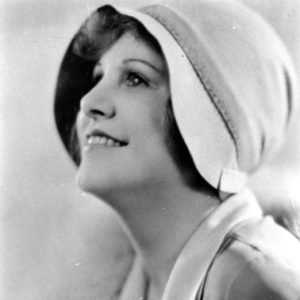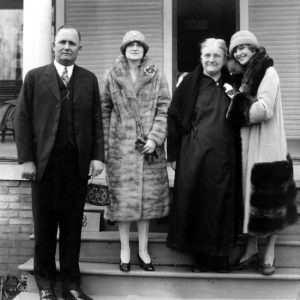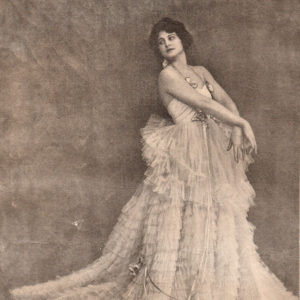calsfoundation@cals.org
Mary Sybil Kidd Lewis (1897–1941)
Mary Sybil Kidd Lewis was possibly the most publicized singer of the 1920s. Using her childhood training, she climbed her way to grand opera, gaining stage experience through vaudeville and operetta. Her career included radio performances and recordings with His Master’s Voice (HMV), Victor, and RCA.
Mary Kidd was born on January 29, 1897, in Hot Springs (Garland County) to Charles and Hattie Kidd. Her father died about the time her brother was born two years later. Her impoverished mother moved with the children to Dallas, Texas. After the children lived in a series of foster homes, her brother was sent to Chicago, Illinois, to live with relatives. Her mother remarried but was unable to care for her children, and the child Mary Maynard (having taken her stepfather’s surname) was sickly and malnourished. In 1905, an elderly Methodist pastor, William Fitch, and his wife, Anna, took the young child into their home after having provided the girl with food and clothing for some time. Their own son, Frank, was a minister and had three children about the same age as Maynard.
Anna Fitch tutored Maynard in schoolwork, and William Fitch trained her in music. In August 1906, the family moved to Eureka Springs (Carroll County), where Fitch was assigned to the First Methodist Episcopal Church. Maynard began to be noticed for her solos during the services.
In early 1908, William Fitch was named pastor of Trinity Methodist Episcopal Church in Judsonia (White County), where Maynard’s vocal talents were noticed again. His health failing, Fitch was assigned to the Little Rock Mission in 1909. As a parsonage was not provided in this assignment, Anna Fitch returned to her home in Holmes County, Ohio, and asked her father for her anticipated inheritance; she soon returned to Little Rock (Pulaski County) carrying $4,000 in gold, which she used to build one of the first houses in the Pulaski Heights subdivision. This is the place Maynard called home.
In about 1912, chafing at the restrictions in the Fitch home, Maynard left to live with Henry Franklin Auten, a friend and influential Arkansas politician, real estate agent, and entrepreneur. An oprhan himself, Auten had taken in other disadvantaged children. He had heard Maynard sing and believed that she could establish a career singing. She enrolled in Little Rock High School, her first classroom experience, and received vocal lessons from Alice Henniger.
In 1915, Mary Maynard married J. Keene Lewis of Little Rock but left him to join a traveling vaudeville troupe. After she became famous, her ex-husband demanded his name not be used, so for publicity purposes she eliminated mention of the marriage and changed her birthday to January 9, 1900, making it appear that she left Little Rock as a teenager rather than a young married woman. She retained the surname of Lewis.
Vaudeville took Lewis to Hollywood, where she appeared in silent films before moving to New York City. She signed a contract with Florenz Ziegfeld as a prima donna in his Follies of 1921. Although all the Follies were spectacular, the Follies of 1922 was climaxed by Charles LeMaire’s “Lace Land,” featuring elaborate costumes which achieved a theatrical glorification. Lewis herself wore a famous costume of peasant design with the lace treated with radium. The newly identified element provided a novel, eerie glowing quality in the dark. When the lights were turned off, the ghost of the dress and Lewis’s face, luminous in the glow from the peasant cap of lace, were all that could be seen on stage while she sang “Weaving.” About a month after the show opened, her health broke down. She spent three months in the hospital, probably from radiation poisoning, the first indication of her many health problems.
The salary of the Follies allowed her to undertake vocal studies with noted vocal coach William Thorner, who encouraged her to follow her dream of grand opera. After an audition with the Metropolitan Opera in New York, Lewis pursued further study and had her opera debut in Europe, as Marguerite in Faust, on October 19, 1923, in the Vienna Opera House. After achieving recognition, Lewis recorded in 1924–25 for His Master’s Voice in England. Returning home in the fall of 1925, Lewis received a contract with the Met for the next season. She debuted as Mimi in La Bohème on January 28, 1926.
On March 26, 1926, Lewis returned to Little Rock to receive the greatest demonstration of welcome accorded to any individual of the state up to that time. She arrived at Little Rock from Hot Springs, where she had given an operatic concert accompanied by Alice Henniger, her former teacher and friend. Lewis was welcomed by Governor Thomas Terral at the State Capitol, and she was presented a golden “Key of the City” by Mayor Charles E. Moyer.
Lewis recorded a second round in America in 1926–27 for HMV and Victor Talking Machine Co.
The first season at the Met ended with her sudden marriage to the Met’s German bass/baritone, Michael Bohnen, on April 15, 1927. The ceremony was performed by New York’s mayor, Jimmy Walker. The disastrous marriage to Bohnen and her own alcoholism began to take a toll on Lewis’s career. The marriage ended in Hollywood in 1930, and Lewis sailed for Europe as the worldwide economic depression forced cuts in theatrical productions.
Lewis married Standard Oil Company vice president Robert L. Hague in Portland, Maine, on September 19, 1931. She spent the next few years traveling to Europe and back and was among the first to board the Hindenburg on its maiden flight to Germany in 1936. Although not performing professionally, she made many appearances for benefit causes. She appeared with John McCormack, the popular Irish tenor, at a fundraising concert for St. Benedict the Moor, a mission church, on December 17, 1933. She made radio appearances over New York’s WYNC and WMCA stations in 1935. On January 30, 1936, Mary Lewis assisted with planning one of the celebrations in honor of President Franklin Roosevelt’s fifty-fourth birthday. The nationwide benefits were a marathon effort to raise funds to help with the treatment of those afflicted with polio.
In 1937, Lewis made a substantial number of recordings for the Thesaurus series for radio broadcast. The discs were produced for NBC by RCA. A collection of her recordings from HMV, Victor Talking Machine Co., and the Thesaurus series has been re-mastered and reproduced on a set of CDs by Ward Marston, a music lover and sound engineer. The two-CD set by Marston Records of Swarthmore, Pennsylvania, Mary Lewis, the Golden Haired Soprano, was released in October 2005.
Lewis was separated from Hague, who died on March 8, 1939, leaving her an estate that consisted of indebtedness. Lewis herself died on December 31, 1941, in New York, following a lengthy illness. After services in New York City, a second service was held on January 5, 1942, at the Second Baptist Church in Little Rock. She is buried in Pinecrest Memorial Park in Alexander (Pulaski and Saline counties).
For additional information:
Abernathy, Mamie Ruth Stranburg. “Mary Lewis, Lyric Soprano Hot Springs Native and Opera Singer.” The Record 48 (2007): 165–167.
Dougan, Michael B. “An Arkansas Aria.” Arkansas Times, August 4, 2005, pp. 10–12.
———. “Mary Sybil Kidd Lewis (1897–1941): ‘I’m from the South and I’ve Got Plenty of Rhythm.’” In Arkansas Women: Their Lives and Times, edited by Cherisse Jones-Branch and Gary T. Edwards. Athens: University of Georgia Press, 2018.
———. “A Touching Enigma: The Opera Career of Mary Lewis.” Arkansas Historical Quarterly 36 (Autumn 1977): 258–279.
Marston, Ward. Mary Lewis, the Golden Haired Soprano. CD set and booklet. Swarthmore, PA: Marston Records, 2005.
Zeman, Alice Fitch. Mary Lewis—The Golden Haired Beauty with the Golden Voice. Little Rock: Rose Publishing, 2001.
Alice Zeman
Paw Paw, Illinois
 Arts, Culture, and Entertainment
Arts, Culture, and Entertainment Early Twentieth Century, 1901 through 1940
Early Twentieth Century, 1901 through 1940 Music and Musicians
Music and Musicians Mary Lewis
Mary Lewis  Mary Lewis (right) and Friends
Mary Lewis (right) and Friends  Mary Lewis
Mary Lewis 




Comments
No comments on this entry yet.